Navigation Menu
Contact Us
- Email:
- info@wxavatar.com
- Address:
- Yurong Village, Yuqi Street, Huishan District, Wuxi, China.
Release Date:Jul 05, 2025 Visit:25 Source:Roll Forming Machine Factory
The evolution of stacking systems is transforming supply chain operations by improving efficiency, accuracy, and scalability. As businesses face increasing demands for faster order fulfillment and optimized storage, next-generation stacking solutions are playing a crucial role in modern logistics. This article explores the key benefits and advancements of these systems in supply chain management.

1. Increased Storage Density and Space Utilization
Next-gen stacking systems maximize warehouse space by utilizing vertical storage more effectively. Automated stacking cranes (ASCs) and high-density racking systems allow businesses to store more goods in the same footprint, reducing the need for additional warehouse space. This is particularly valuable in urban areas where real estate costs are high.
2. Improved Efficiency Through Automation
Automated stacking systems minimize manual handling, reducing labor costs and human error. Robotic palletizers and automated guided vehicles (AGVs) work seamlessly with warehouse management systems (WMS) to optimize stacking patterns, ensuring faster loading and unloading processes. This leads to shorter cycle times and higher throughput.
3. Enhanced Inventory Accuracy
Advanced stacking technologies integrate with real-time tracking systems, such as RFID and barcode scanning, to maintain precise inventory records. Automated systems ensure that goods are stored and retrieved in the correct locations, reducing misplaced items and improving order accuracy.
4. Scalability for Growing Operations
Modern stacking solutions are designed to adapt to changing business needs. Modular racking systems and software-driven stacking algorithms allow warehouses to scale operations without major infrastructure changes. This flexibility supports seasonal demand fluctuations and long-term business growth.
5. Safer Working Conditions
Automated stacking reduces the need for workers to operate heavy machinery or handle bulky loads manually. With fewer manual interventions, the risk of workplace injuries decreases, contributing to a safer warehouse environment.
6. Integration with Smart Warehouse Technologies
Next-gen stacking systems are increasingly compatible with IoT-enabled devices and AI-driven analytics. These integrations enable predictive maintenance, dynamic slotting optimization, and real-time adjustments to stacking strategies based on demand patterns.

Conclusion
Next-generation stacking systems are reshaping supply chain operations by optimizing space, improving efficiency, and enhancing inventory management. As automation and smart technologies continue to advance, businesses that adopt these solutions can achieve greater operational agility and competitiveness. By leveraging these innovations, companies can streamline their logistics processes while meeting the growing demands of modern commerce.